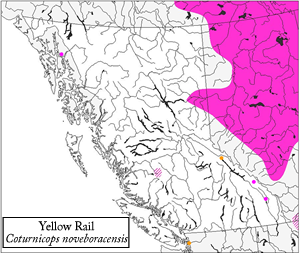Very few individuals have been observed in B.C., and the vast majority of records pertain to singing males which produce a very unique and distinctive song. When observed, this species is likely to be mistaken only for juvenal-plumaged Sora, and several previously-cited records have apparently been the product of such a misidentification. Juvenile Sora has extensive buff on the face and breast, which is responsible for the confusion with similarly-plumaged Yellow Rail. If seen in flight, such as an individual flushed from marshy vegetation, the large white patch on the secondaries of the Yellow Rail should immediately serve to distinguish it from a juvenile Sora (but beware of the narrow white trailing edge to the secondaries of juvenile Sora, which may cause some confusion with the white secondary patch of Yellow Rail). The buff-striped upperparts of Yellow Rail are also diagnostic (upperparts of Sora are brown and finely speckled with white). Yellow Rail is a noticeably smaller species and is exceedingly secretive and extremely unlikely to be observed in the open (except for a bird that is flushed from under foot and flies a short distance before dropping back into cover). The Sora, in contrast, is much bolder and regularly ventures into the open, sometimes even swimming in open water. Finally, Yellow Rail is closely associated with wet meadows and sedge marshes, whereas Sora is commonly encountered in a wide variety of marshy habitats (including cattail marshes, tule stands, etc.); thus, any potential Yellow Rail outside of the very narrow habitat range of the species is more likely to be a juvenile Sora and should be identified with caution.
| The male’s song is a unique and very distinctive series of dry, mechanical clicks in a consistent pattern of two clicks followed by a more rapid series of three clicks: tic, tic, tictictic…..tic, tic, tictictic…..tic, tic, tictictic…. This song is repeated for long periods of time without pause, and is most frequently given throughout the night (although it is also given during the day, particularly in the early morning). It is very reminiscent of the sound made by tapping two small stones together. Other calls that are heard less frequently include a descending cackle of about 10 notes, a series of three or four clunking notes that sound like distant knocking on door, quiet croaking notes, and soft wheezing or clucking notes. Source: Bookhout (1995); Sibley (2000) |
Courtship
The mechanism of pair formation of this species is poorly known, but appears to largely involve the male’s song as a means of courtship display. It is likely monogamous throughout the breeding season, although serial monogamy has been reported from captive birds.
Nest
The nest is constructed ~1 month before the eggs are laid, and is therefore likely built during June in B.C. Both sexes participate in the nest-building process (although the female contributes more effort, particularly in the latter stages), and sometimes a second nest is built but is used only for brooding the young. The nest is placed on the ground or up to 15 cm high (sometimes above shallow water) and is woven into the surrounding stems of sedges and grasses; it is usually situated beneath overhanging dead vegetation for concealment. The nest itself is a small, thick, rather deep cup 7-10 cm wide and 3-8 cm deep. It is composed of the stems and leaves of sedges and grasses that are gathered from the vicinity of the nest site.
Eggs
A clutch of (5) 8 (10) eggs are laid after the completion of the nest (likely in late June or early July in B.C.) and are incubated by the female for 13-18 days before hatching. The smooth, non-glossy eggs are creamy-buff and are sparsely to heavily speckled around the larger end with reddish-brown spots. Although eggs have not been recorded in B.C., they are likely present in the province between late June and mid-July.
Young
The young are semi-precocial upon hatching and are completely covered in long, glossy black down (sometimes with a faint greenish cast on the head and a dull brownish cast on the body); the bill is bright pink when first hatched, but gradually becomes whitish. The young are able to stand and walk within a day of hatching, and by the second day they leave the nest to forage alongside the female. They continue to be fed by the female for 5 days after leaving the nest, but subsequently acquire all food on their own. They are brooded by the female for ~3 weeks after they leave the nest, often retiring to a special ‘brood nest’ for brooding. The young are able to fly weakly at ~35 days of age, after which time they become independent. Although they have never been documented in the province, dependent young are likely present in B.C. between early July and early to mid-August.
Source: Bookhout (1995); Baicich and Harrison (1997)
|
This species forages almost exclusively within very dense vegetation (usually sedges) and spends almost all of its time concealed; thus its foraging habits are poorly known. It feeds primarily on aquatic and semi-aquatic invertebrates, with small freshwater snails forming the bulk of its diet; other prey species include insects and their larvae, earthworms, and spiders. It also consumes the seeds of sedges and other aquatic plants, especially outside of the breeding season. It picks its prey from the surface of the mud, from low vegetation, and from the surface of the water or even from 3-4 cm below the surface of the water.
Source: Bookhout (1995)
|
|

